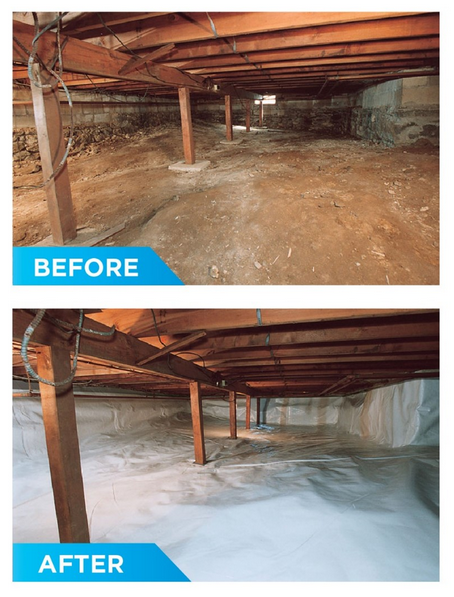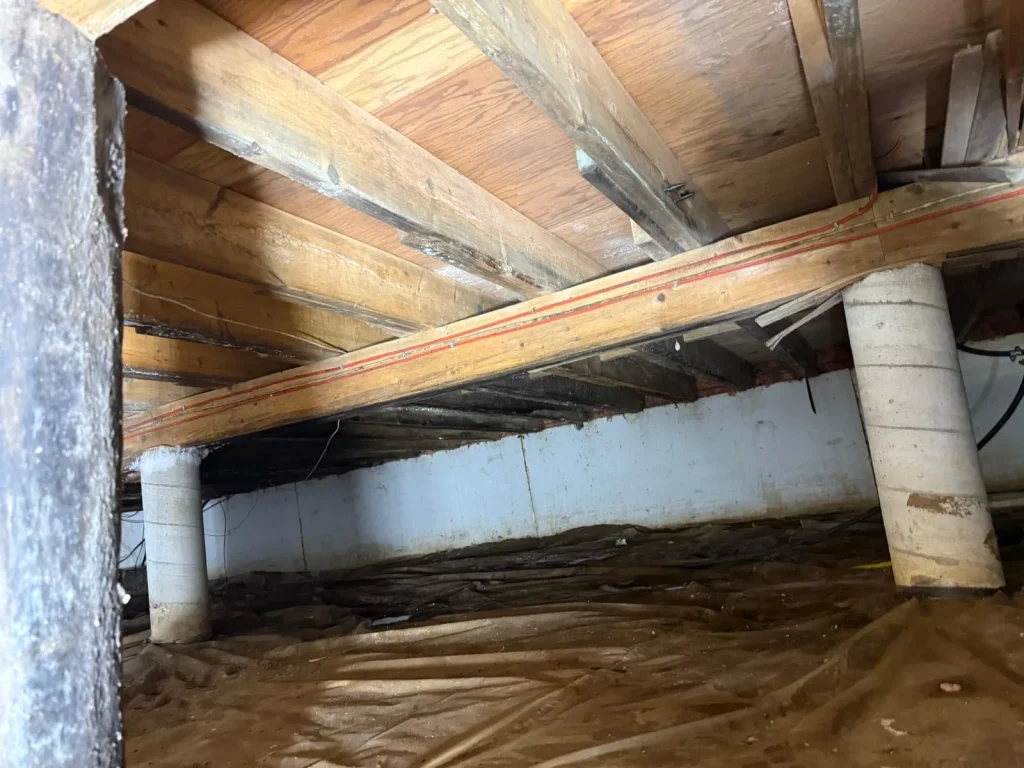Updated on 10-Dec-2025
Crawl space mold is one of the most overlooked home hazards in Toronto.
Hidden beneath floors, it can spread silently, affecting your indoor air, your family’s health, and even your property’s value.
In this article, we’ll explore the real dangers of crawl space mold, what Health Canada and IICRC guidelines say, and when it’s time to call for professional crawl space mold remediation.
Table of Contents
Why Crawl Space Mold Shouldn’t Be Ignored
Most homeowners think mold is only a cosmetic issue.
The truth?
Crawl space mold is a sign of ongoing moisture problems and can have far-reaching effects:
-
Hidden Growth – Mold spreads behind insulation, wood beams, and ductwork before it becomes visible.
-
Air Circulation Pathways – Up to 40% of the air you breathe on the main floor comes from your crawl space. If that air carries mold spores, your family is exposed daily.
-
Structural Red Flags – Mold doesn’t just stain wood — it can weaken floor joists and compromise long-term structural stability.
📍 In Toronto’s humid summers and damp winters, crawl space conditions are ideal for mold to thrive — making early detection essential.
Health Risks of Crawl Space Mold (According to Experts)
Health Canada warns that no level of indoor mold exposure is safe.
Prolonged exposure can lead to:
-
Respiratory Issues – Chronic coughing, wheezing, throat irritation, and lung infections in severe cases.
-
Worsening of Asthma & Allergies – Children, seniors, and those with asthma are most at risk.
-
Eye & Skin Irritation – Red, itchy eyes and rashes from airborne spores.
-
Long-Term Health Effects – Studies suggest links to chronic sinusitis and immune suppression in sensitive individuals.
💡 IICRC S520 Standard for Professional Mold Remediation also highlights that crawl spaces are high-risk environments because of limited ventilation and high humidity, requiring professional containment and HEPA filtration during removal.
👉 If you’re noticing unexplained allergy symptoms or musty odors at home, it may be your crawl space. Don’t ignore the warning signs — book a free inspection with Ultimate Mold Crew today.
Structural Risks of Crawl Space Mold
Crawl space mold isn’t just a health concern — it can eat away at your home’s foundation materials over time.
-
Wood Rot & Weakening Joists – Mold thrives on cellulose in wood, slowly breaking down beams, subfloors, and supports. This can cause sagging floors or uneven settling.
-
Compromised Insulation – Moisture and mold ruin fiberglass insulation, making it fall apart and reducing energy efficiency.
-
HVAC Contamination – If ducts run through your crawl space, mold spores can spread throughout your entire home.
📍 In Toronto, where crawl spaces often face condensation in winter and high humidity in summer, these risks are magnified. Structural repairs can become extremely costly if mold is ignored for too long.
Property Value & Financial Impact
For Toronto homeowners, crawl space mold isn’t just a maintenance issue — it’s a financial liability:
-
Lower Resale Value – Home inspectors in Ontario are trained to flag mold problems. A moldy crawl space can derail a sale or force you into costly last-minute remediation.
-
Increased Energy Bills – Damaged insulation and humid air mean your heating and cooling systems work harder, driving up monthly costs.
-
Expensive Repairs Later – Ignoring crawl space mold leads to wood replacement, insulation re-installation, or even foundation repairs — far costlier than early remediation.
💡 Preventive action is always cheaper than structural restoration. A free inspection today can save thousands tomorrow.
👉 Ready to protect your home investment? Schedule a Free Mold Inspection in Toronto with Ultimate Mold Crew today.
How to Prevent Crawl Space Mold in Toronto Homes
Once mold is removed, the key is making sure it never comes back.
In Toronto’s climate — with damp winters and humid summers — moisture control is critical.
Professional prevention strategies include:
-
Crawl Space Encapsulation – Installing a heavy-duty vapor barrier across floors and walls to lock out moisture.
-
Dehumidifier Installation – Keeping humidity below 50%, as recommended by Health Canada, to stop mold growth conditions.
-
Drainage & Sump Systems – Redirecting groundwater away from your foundation to prevent standing water.
-
Sealing Vents & Gaps – Eliminating pathways for outside moisture and pests.
-
Regular Inspections – Annual crawl space checks help catch early warning signs before they become serious problems.
📍 By combining remediation with prevention, Toronto homeowners can protect both health and property value long-term.
Final Thoughts — Protect Your Home & Health Today
Crawl space mold is more than just a hidden nuisance — it’s a health risk, a structural threat, and a financial burden for Toronto homeowners.
The good news?
With the right team and proven remediation process, you can eliminate mold permanently and prevent it from returning.
At Ultimate Mold Crew, our IICRC-certified, WSIB-insured experts have over a decade of experience helping Toronto families reclaim clean, healthy homes. From free inspections to mold removal and prevention solutions, we handle it all.
📞 Call 647-985-2739 or Request Your Free Crawl Space Mold Inspection → today and take the first step toward a safer, healthier home.

Crawl Space Mold FAQs — Health & Safety
Q1. Is it safe to live in a home with crawl space mold?
Not recommended. Air from the crawl space mixes with the air you breathe upstairs, carrying spores that can irritate the nose, eyes, throat, and lungs—especially for kids, seniors, and anyone with asthma or allergies.
Q2. Can crawl space mold trigger asthma or allergies?
Yes. Mold fragments and spores are common asthma and allergy triggers. If symptoms improve when you’re away from home and worsen when you return, your crawl space could be a source.
Q3. Are some molds “toxic”?
Different molds affect people differently. The bigger issue is moisture and exposure—any ongoing mold growth indoors is a problem and should be removed following professional standards (IICRC) with proper containment and filtration.
Q4. Will bleach fix crawl space mold?
Bleach can discolor surfaces but doesn’t solve the root cause or reach porous materials. Without containment, HEPA filtration, and moisture control, mold often returns.
Q5. When should I call a professional?
If growth covers more than a small patch, you smell persistent musty odours, see recurring growth, or have standing water/high humidity, bring in pros. Confined spaces, hidden moisture, and ducts make DIY risky and ineffective.
Crawl Space Mold FAQs — Remediation & Prevention
Q6. How long does professional remediation take?
Most crawl space projects take 1–3 days depending on access, extent, and whether prevention steps (encapsulation, dehumidifier) are included.
Q7. How do you prevent mold from coming back?
Control moisture: install a vapor barrier/encapsulation, keep relative humidity below ~50% with a dehumidifier, seal vents/gaps, improve drainage, and schedule periodic inspections.
Q8. What is crawl space encapsulation—and do I need it?
Encapsulation lines floors/walls with a heavy-duty vapor barrier, often paired with drainage and a dehumidifier. It’s recommended when you have chronic humidity, soil moisture, or past mold issues.
Q9. What does crawl space mold removal cost in Toronto?
Costs vary with size, access, and prevention add-ons. Crawl spaces tend to be pricier than open areas due to tight access and the need for long-term moisture control. We provide a free on-site estimate after inspection.
Q10. Will my insurance cover mold remediation?
Policies differ. Sudden, covered water events may qualify; long-term humidity or maintenance issues often don’t. We can document findings to support your discussion with the insurer.
Related posts:
- Is Mold Dangerous To Your Health – Exposure Risks & Dangers
- What Is Ideal Crawl Space Humidity Level To Prevent Mold?
- What Are The Signs Of Crawl Space Mould In Toronto Homes?
- Signs of Mold Behind Drywall: Health Risks & Detection[2025]
- Mold Growth & Indoor Air Quality – Health Risks & Prevention [2025]
- Crawl Space Encapsulation – Mold & Moisture Prevention [2025]


